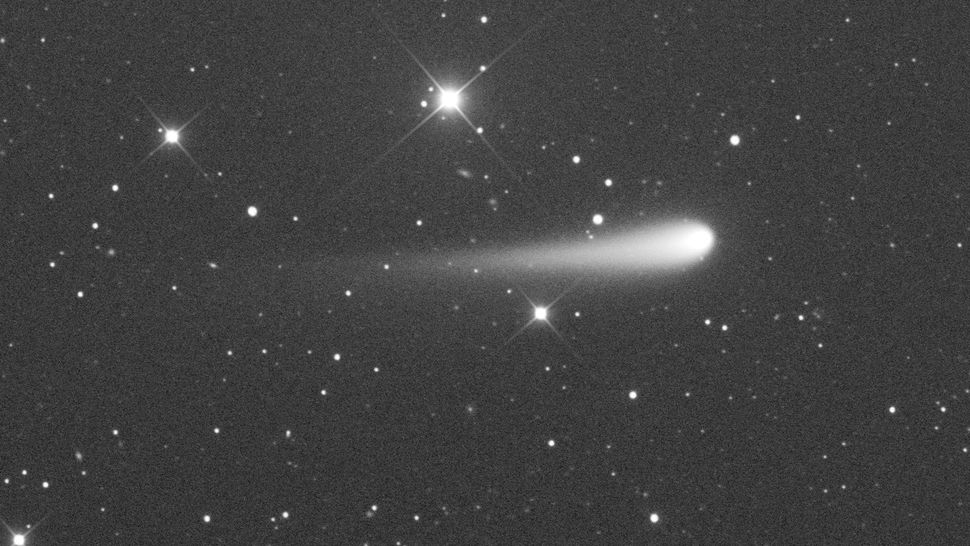We are now coming down the home stretch regarding comet Tsuchinshan-ATLAS.
First sighted at China’s Purple Mountain Observatory on Jan. 9, 2023 and independently on Feb. 22 by the Asteroid Terrestrial-Impact Last Alert System (ATLAS), this object has been the subject of considerable speculation as to whether it will develop into a spectacular naked-eye sight this fall or whether this potential sizzler might ultimately turn out to be a fizzler.
Back in early July, news spread quickly on social media that the comet was doomed. Dr. Zdeněk Sekanina, a Czech-American astronomer and comet expert, published a paper indicating that the comet was in “an advanced stage of fragmentation,” even going so far as referring to the comet’s eventual fate in the title of his paper as an “Inevitable Endgame.” And yet, nearly two months later, the comet still appears quite healthy.
Almost out of sight
Currently, the comet is unobservable from the Northern Hemisphere. It is situated well to the south of the ecliptic, within the boundaries of the faint constellation of Sextan the Sextant. As a result, it is below the horizon at sunset.
But even from the Southern Hemisphere, getting views of the comet is difficult, if not impossible. From Sydney, Australia, for instance, the comet currently stands only five-degrees above the southwest horizon just a half-hour after sunset in a bright twilight sky.
If you want to get a closer look at comets in the night sky, be sure to take a look at our guides to the best telescopes and best binoculars.
And if you want to photograph visible comets, we have tips for how to photograph comets, as well as guides to the best cameras for astrophotography and best lenses for astrophotography.

Such circumstances have made gauging a reliable estimate of just how bright the comet currently is, very uncertain. The last observation from Thomas Lehmann in Chile, on Aug. 12 placed the comet at magnitude +8.2.
Notes Jonathan Shanklin of the British Astronomical Association’s (BAA) Comet Section: “In addition to the errors in the prediction, there are also errors in the observations themselves — each observer sees a comet in a different way, so that some observers consistently estimate brighter than average, others are consistently fainter, and some are erratic. With enough observations these effects all cancel out, but there is always a risk of bias due to a predominance of one sort of observer.”
However, there is another method now being employed to get views of the comet. Some have turned to a spacecraft to get a view of Tsuchinshan-ATLAS.
Comet views in STEREO
The spacecraft in question is STEREO (Solar TErrestrial RElations Observatory). In October 2006, two identical spacecraft (STEREO-A, STEREO-B) were launched into orbits around the sun that cause them to respectively pull farther ahead of and fall gradually behind the Earth. This enabled unique stereoscopic imaging of the sun and solar phenomena, such as coronal mass ejections.
Unfortunately, contact with STEREO-B was lost in 2014 after it entered an uncontrolled spin preventing its solar panels from generating enough power, but STEREO-A is still operational.
And in its wide-field views of the sun, the comet can also be seen. And on Aug. 17, an image of the comet was rendered from STEREO A. Amateur astronomer, Toni Scarmato was able to estimate the comet’s V band magnitude (apparent brightness) at magnitude +7.2, which is a full magnitude (2.5 times brighter) than Thomas Lehmann’s ground-based observation had indicated just five days earlier.
Hope springs eternal
So, the comet continues to slowly improve in brightness as it nears the sun, and showing no apparent signs of disintegrating, at least in the immediate future.
Hopefully, the comet will continue to remain intact and undiminished as it presses closer to the sun, reaching its closest approach on Sept. 27. For several days thereafter, Tsuchinshan-ATLAS might be sighted about 45 minutes before sunrise, very low near the east-southeast horizon, and possibly shining at magnitude +2 (as bright as Polaris the North Star).
But the best show could be reserved for evening skywatchers during the second and third weeks of October as the comet literally vaults upward in the west-southwest sky. We will have more to say in the coming weeks, so stay tuned!
Don’t miss our night sky tonight page and monthly skywatching calendar for more upcoming night sky events.
Joe Rao serves as an instructor and guest lecturer at New York’s Hayden Planetarium. He writes about astronomy for Natural History magazine, the Farmers’ Almanac and other publications.